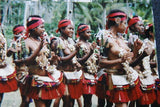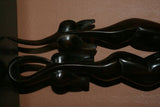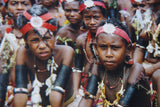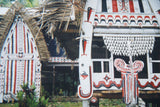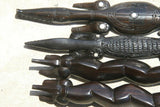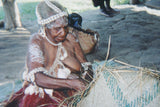Rare Hand Carved Ebony Wood Chief Power staff, magic amulet meant to intimidate & scare evil spirits, Trobriand Islands, Massim Culture, Kula Ring, South Pacific
Rare Hand Carved Ebony Wood Chief Power staff, magic amulet meant to intimidate & scare evil spirits, Trobriand Islands, Massim Culture, Kula Ring, South Pacific ( Choose 1A32 or 1A33)
Choice between 2 long smooth abstract ebony crocodiles, carved amulets from the Trobriand islands, Massim region, Melanesia.
Unique South Pacific Art.
Long smooth abstract ebony sculpture created to warn off bad magic & dangerous salty crocodiles, a protective symbol used by shamans. Massim Culture. Oceanic Art.
Choose Item 1A32 or item 1A33, in our inventory, crocodiles seen on most of the photos, one is 13 1/4" tall and the other 14" tall. They look like a pair but their tails differ.
Splendid example of melanesian art. Great unique original handcarvings from the Kula ring, created out of solid ebony by a Trobriand sculptor, and collected from a chief during one of our trips to the remote Trobiand islands.
Crocodile alligator carving used as protection and amulet against the risk of being devoured by a saltie croc, the man-eating Ocean going Crocodile from Papua New guinea (PNG).
Sign of power and strength for the owner as well.
Collected in the isolated Trobriands, PNG , this object is beautifully carved by a local master carver with rudimentary tools. Amazingly perfect considering the basic tools used such as pieces of broken shells, rusted nails from shipwrecks found on the beaches, and sea ray, shark skin or an animal horn or tusk rubbed for days against the surface till all is smooth, among other sanding materials, which produces a nice sheen on the wood. It is very hard to come across such collectibles unless you go there.
These beautiful art pieces are rare items of the Kula ring. We collected them while in the field in these remote rarely visited islands north of Papua New Guinea. We collected many beautiful pieces while in the Trobriands from carvings (created out of kwila, rosewood and ebony) to costumes, drums and Kula ring exchange items that we list whenever we have time.
We show pictures of people and yam houses we took when we went there.
In these islands which are rarely visited, outside influence is at a minimum. The extremely skilled carvers inspire themselves from what is around them as they have access to nothing else: the natives, birds, fish, pigs, marine turtles, snakes and whatever they see in their dreams such as dragons or mystical figures.
Some of these items have very important meanings as they are used as part of the Kula ring trade system that has existed between the islands for centuries.
The Kula ring is a system of exchange involving annual inter-island visits between trading partners who exchange highly valued shell ornaments and other things during year long sea travels.
In his Argonauts of the Western Pacific (1922), Malinowski analyzed the kula ring, the exchange of shell valuables in a circle around the chain of the . These ornaments were traded from island to island in a counter-clockwise direction: A long time ago when the days were longer and the nights shorter lived a hero called Tava who at times took the form of a snake. Tava was known to pass between the villages that are identified as the active . When he was present in a village the people were said to have good fortune and prosper. His location was known only to one woman in each village and she would feed and tend to him. If he felt mistreated or betrayed at any time he would move on to the next island. On his departing the good fortune would also depart with him. He would nevertheless leave each village with a trade.
This trade ranged from a surplus of pigs and yams in the Trobriands to the fine art or pottery found in the Amphletts. Other places became known for obsidian and Betel nut. It is believed that this myth could be one of the origins of the and the way it functions. Kula is a ritualized trading culture existing in eastern which the Trobriands are part of. It is essentially network of villages joined by a common trade route, known as the . By analogy, Kula allows you to experience the magic and legends of . Kula was and still is a life sustaining cultural exchange. It is unfortunate that much of the time and energy that was used in the past to hold together the social foundation is now being clouded with the desire for money, a by-product of a tourism-based economy. With influences such as these and the advancement of technology, the intricate pattern in which traditional values are based is slowly eroding. Kula is the basis of mental and physical well-being. The has always been associated with making contact with far off neighbors. Traditionally two kinds of items were traded; arm bands carved from the toea shell know as Mwali and spondylus shell necklaces, Soulava. Each of these items was traded individually. Mwali and Soulava traveled in opposite directions around the (group of islands). Mwali passed anticlockwise in the ring and were given with the right hand, the Soulava passed clockwise and was offered with the left hand, first between villages then from island to island.
Such pieces are created & used by the indigenous people of the most primitive areas of Papua New Guinea. These proud people have managed, in the face of continued government and missionary pressure, to maintain a culture of incredible depth and beauty. For the most part, they still live by the same methods as have existed in their remote land for thousands of years.
All our collector and rare items come with pages and pages of research about provenance, and with history of the tribes and photos as well, depending on item and whenever possible. When shipping internationally, we group ship multiple purchases to save you money, and find the best rates available. If you have any questions or want to see research conducted on this piece and photos of tribes, let us know.


















